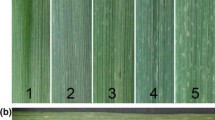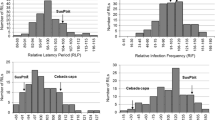Summary
Isolates of the barley mildew pathogen from the air spora over a large part of Europe and from fields of variety mixtures, were tested for virulence against 12 host resistance alleles. Subsamples were tested for their response to triadimenol fungicide and analyzed for 10 DNA loci using RAPD markers and PCR. There was a large range of haplotypes spread over Europe; irregularity in the distribution was probably due mainly to non-uniform use of the corresponding host resistances and fungicides. A large range of variation was also detectable within individual fields. Positive gametic disequilibria distorted the distribution of virulence alleles among haplotypes and reduced the number of haplotypes detectable in the sample. Analysis of the spread of the newly selectedVal3 allele into different European sub-populations indicated that gene flow throughout the population may be rapid for alleles that have a selective advantage.
Fungicide resistance was widespread in areas known for intensive use of fungicides for mildew control. Four classes of fungicide response were detectable and particular virulence haplotypes were found to be characteristic for each class.
Variety mixtures used in the former German Democratic Republic (GDR) reduced mildew infection, and thus fungicide use, during the years 1984–1991 despite the limited variation in host resistance among the mixtures. A tendency for complex pathogen races to increase in mixture crops was reversed by the large-scale re-introduction of fungicides for mildew control in 1991. The mixture strategy appeared to be more successful than using the same resistance alleles in pure monoculture or combining them in a single host genotype.
Similar content being viewed by others
References
Andrivon, D. & E., Limpert, 1992. Origin and proportions of components of populations ofErysiphe graminis f. sp.hordei.. J. Phytopathol. 135: 6–19.
Brown, J.K.M. & J.H., Jorgensen, 1991. A catalogue of mildew resistance genes in European barley varieties. In: J.H., Jorgensen (Ed.), Integrated control of cereal mildews: virulence patterns and their change, 263–286. Riso National Laboratory, Roskilde.
Brown, J.K.M. & M.S., Wolfe, 1990. Structure and evolution of a population ofErysiphe graminis f. sp.hordei. Plant Pathol. 39: 376–390.
Brown, J.K.M., A.C., Jessop & H.N., Rezanoor, 1991. Genetic uniformity in barley and its powdery mildew pathogen. Proc. Roy. Soc. London B. 246: 83–90.
Brown, J.K.M., C. Simpson & M.S. Wolfe, 1992. Adaptation of barley powdery mildew to varieties in which previously exposed resistance genes are combined. Plant Pathol. (submitted).
Brückner, F., 1982. Nalez rasi padli na jecmeni (Erysiphe graminis DC.var. hordei Marchal) virulentni pro geny rezistenceMla9 aMla14. Sbor. UVTIZ-Ochr. Rostl., 18: 101–105.
Brückner, F., 1987. Experiences with breeding of spring barley or resistance to powdery mildew in Czechoslovakia. In: M.S., Wolfe & E., Limpert(Eds.), Integrated Control of Cereal Mildews: Monitoring the Pathogen, pp. 39–41. Martinus Nijhoff Publishers, Dordrecht.
Burdon, J.J. & S.R., Leather (Eds.), 1990. Pests, Pathogens and Plant Communities. Blackwell Scientific Publications, Oxford.
Hermansen, J.E., U., Torp & L.P., Prahm, 1978. Studies of transport of live spores of cereal mildew and rust fungi across the north sea. Grana 17: 41–46.
Hovmoller, M. & H., Ostergaard, 1991. Gametic disequilibria between virulence genes in barley mildew populations in relation to selection and recombination. II. Danish populations. Plant Pathol. 40: 178–189.
Islam, M.R., A. Jahoor & G. Fischbeck, 1991. Reactions of differential barley lines carryingMla alleles to European and Israeli powdery mildew isolates. Proc. 6th Int. Barley Gen. Symp. 589–592.
Kolster, P., L., Munk, O., Stolen & J., Lohde, 1986. Nearisogenic barley lines with genes for resistance to barley mildew. Crop Sci. 26: 903–907.
Limpert, E., 1987a. Frequencies of virulence and fungicide resistance in the European barley mildew population in 1985. J. Phytopath. 119: 298–311.
Limpert, E., 1987b. Spread of barley mildew by wind and its significance for phytopathology, aerobiology and for barley cultivation in Europe. In: G., Boehm & R.M., Leuschner (Eds.), Advances in Aerobiology. Birkhäuser, Basel.
Limpert, E. & G., Fischbeck, 1987. Distribution of virulence and of fungicide resistance in the European barley mildew population. In: M.S., Wolfe & E., Limpert (Eds.), Integrated Control of Cereal Mildews; Monitoring the Pathogen, pp. 9–30. Martinus Nijhoff Publishers, Dordrecht.
Limpert, E. & E. Schwarzbach, 1981. Virulence analysis of powdery mildew of barley in different European regions in 1979 and 1980. Proc. 4th Int. Barley Genet. Symp. 458–465.
McDermott, J.M., B.A., McDonald, R.W., Allard & R.K., Webster, 1989. Genetic variability for pathogenicity, isozyme, ribosomal DNA and colony color variants in populations ofRhynchosporium secalis. Genetics 122: 561–565.
Müller, K., E., Limpert & M.S., Wolfe, 1991. Breakdown of barley powdery mildew resistanceMla13 in Switzerland. Bull. Swiss Soc. Phytiatry 2: 14 (abstract).
Murray, M.G. & W.F., Thompson, 1980. Rapid isolation of high molecular weight plant DNA. Nucleic Acid Res. 8: 4321–4325.
Newton, A., C.E., Caten & R., Johnson, 1985. Variation for isozymes and double-stranded RNA among isolates ofPuccinia striiformis and two other cereal rusts. Plant Pathol. 34: 235–247.
O'Dell, M., M.S., Wolfe, R.B., Flavell, C.G., Simpson & R.W., Summers, 1989. Molecular variation in populations ofErysiphe graminis on barley, oats and rye. Plant Pathol 34: 340–351.
Ostergaard, H. & M., Hovmoller, 1991. Gametic disequilibria between virulence genes in barley mildew populations in relation to selection and recombination. I. Models. Plant Pathol. 40: 166–177.
Schwarzbach, E., 1979. A high throughput jet trap for collecting mildew spores on living leaves. Phytopath. Z. 94: 165–171.
Schwarzbach, E. & G., Fischbeck, 1981. Die Mehltauresistenzfaktoren von Sommer- und Wintergerstensorten in der Bundesrepublik Deutschland. Zeit. Pflanzenz. 87: 309–318.
Welz, G. & J., Kranz, 1987. Effects of recombination on races of a barley powdery mildew population. Plant Pathol. 36: 107–113.
Williams, J.G.K., A.R., Kubelik, K.J., Livak, J.A., Rafalski & S.V., Tingey, 1990. DNA polymorphisms amplified by arbitrary primers are useful as genetic markers. Nucleic Acids Res. 18 (22): 6531–6535.
Wolfe, M.S., 1992a. Barley diseases: maintaining the value of our varieties. Sixth International Barley Genetics Symposium, Vol. 2 1055–1067.
Wolfe, M.S., 1992b. Can the strategic use of disease resistant hosts protect their inherent durability? In: Durable Resistance. Wageningen: PUDOC (in press).
Wolfe, M.S. & J.A. Barrett, 1976. The influence and management of host resistance on control of powdery mildew on barley. Barley Genetics III. Proceedings of the 3rd International Barley Genetics Symposium, Garching, 433–439.
Wolfe, M.S. & C., Caten (Eds.), 1987. Populations of Plant Pathogens: their Dynamics and Genetics. Blackwell Scientific Publications, Oxford.
Wolfe, M.S. & D.R., Knott, 1982. Population of plant pathogens: some constraints on analysis of variation in pathogenicity. Plant Pathol. 31: 79–90.
Wolfe, M.S. & E., Schwarzbach, 1978a. The recent history of the evolution of barley powdery mildew in Europe. In: D.M., Spencer (Ed.), Powdery Mildews, pp. 129–157. Academic Press, London.
Wolfe, M.S. & E., Schwarzbach, 1978b. Patterns of race changes in powdery mildews. Ann. Rev. Phytopathol. 16: 159–180.
Wolfe, M.S., S.E. Slater & P.N. Minchin, 1988. Mildew of barley. In: U.K. Cer. Path. Vir. Surv.: 1987 Ann. Rep. 22–28.
Wolfe, M.S., H., Hartleb, E., Sachs, H., Zimmermann, 1991. Sortenmischungen von Braugerste sind gesünder. Pflanzen-schutz-Praxis 2: 33–35.
Author information
Authors and Affiliations
Rights and permissions
About this article
Cite this article
Wolfe, M.S., Brändle, U., Koller, B. et al. Barley mildew in Europe: population biology and host resistance. Euphytica 63, 125–139 (1992). https://doi.org/10.1007/BF00023918
Issue Date:
DOI: https://doi.org/10.1007/BF00023918




